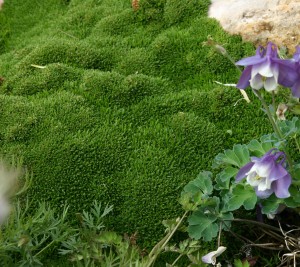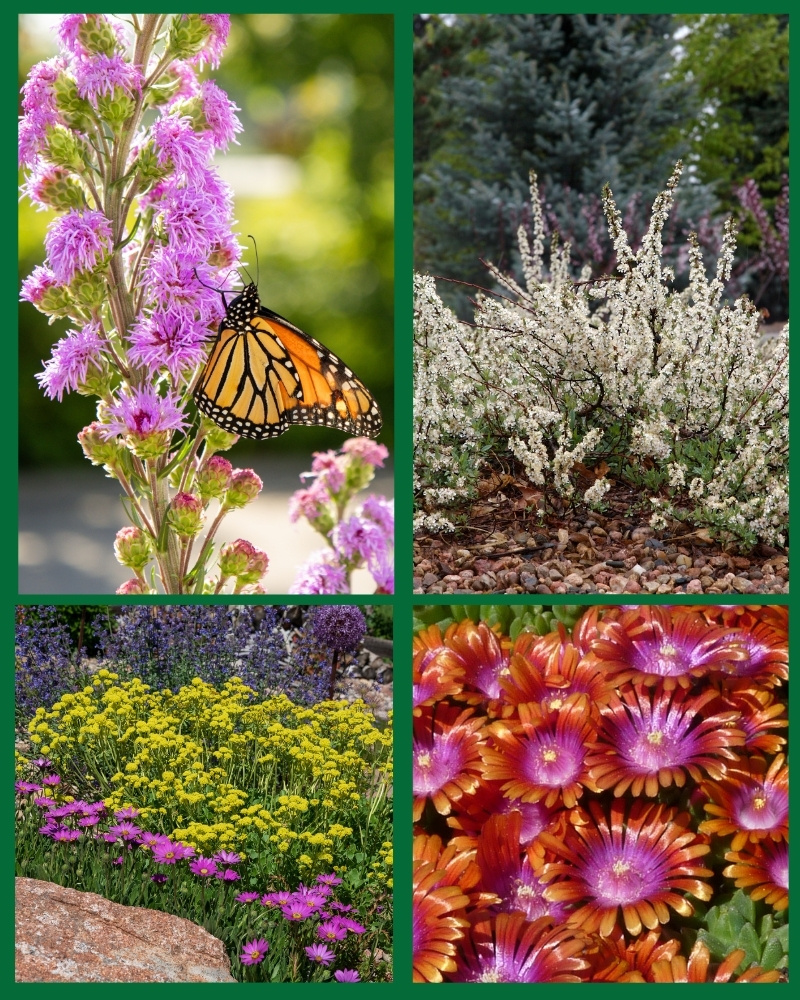Field of green – Arenaria ‘Wallowa Mountains’
 It’s easy to overlook plants that do not offer flashy flowers or exciting seed heads or berries and tend to look similar from one month to another. These plants however are often the workhorses in the garden providing a subtle backdrop to their flasher bedmates. One such plant is Arenaria ‘Wallowa Mountains’. Championed by Plant Select Petites for 2015 as “desert moss’ this cushion forming alpine plant from Oregon’s famed Wallow Mountains is essential in every rock garden, trough, crevice garden or anywhere a mound of bright green is needed.
It’s easy to overlook plants that do not offer flashy flowers or exciting seed heads or berries and tend to look similar from one month to another. These plants however are often the workhorses in the garden providing a subtle backdrop to their flasher bedmates. One such plant is Arenaria ‘Wallowa Mountains’. Championed by Plant Select Petites for 2015 as “desert moss’ this cushion forming alpine plant from Oregon’s famed Wallow Mountains is essential in every rock garden, trough, crevice garden or anywhere a mound of bright green is needed.
Greening in spring with warming temperatures and staying green until bitter cold temperatures turn the older leaves a golden brown ( in full sun the whole plant can turn golden for the winter). It seems to be brightest in spring and fall. By fall its slowly expanding undulating bun of green can be the center of attention in the rock garden. Small white flowers appear sporadically in summer; however the plant is grown more for its evergreen foliage.
For such an adaptable plant a bit of mystery surrounds the origin of Arenaria ‘Wallowa Mountains’. Most people report that, Boyd Kline of Siskiyou Rare Plant Nursery introduced the Arenaria through the Siskiyou Rare Plant Nursery Catalog, at first as a very dense form of Silene acaulis collected in the high Wallowa Mountains, later when it did produce a few sparse flowers, it was determined it was not a Silene but an Arenaria (sandwort). The trail seems to go dead there as no one I have contacted seems to know exactly where Boyd collected the plant and the online Flora of Oregon seems to have no record of the plant. Perhaps Arenaria ‘Wallowa Mountains’ represents an un-described species from Oregon? Regardless of the mystery which seems to surround this superb plant it deserves a spot in your garden.
Site desert moss in full sun or part shade, in moderate to sandy soil. As for watering, it grows under moderate to dry conditions. It will grow well as a groundcover or topdressing in containers, including miniature or fairy gardens, where it can serve as a fairy lawn. It can be grown between pavers, on a path or among other xeric plants. Desert moss survives air temperatures in USDA Zones 4–8, but it will not do well in areas that are Zone 7 and 8 and have high humidity.
View the plant profile here.
Desert Moss
Arenaria ‘Wallowa Mountain’
Perennial
Size: ½ inch tall x 10-14″ wide
Blooms: White, sparse, summer
Sun: Full sun to part shade
Water: Moderate to xeric
Hardiness: USDA Zones 4-8 (zones 7-8 not humid, up to 8150′ elevation)
Culture: Loam or sandy soils
Thanks to Mike Kintgen, Curator of Alpine Collections, Denver Botanic Gardens, for this piece.



Hello I am looking for arenaria wallowa mountains moss. Could you please inform me when the item will be available for purchase?
Thank you,
–Vic
I believe that it was readily available this spring in Colorado Front Range independent garden centers, but this late in the season it’d be best to call around. I know that Tagawa Gardens in Centennial oftens orders a large amount of fresh stock for early fall planting – definitely worth a call to them.
High Country Gardens in Colorado and seeds on Amzon. Pricy!
It’s a VERY slow grower, so I imagine the price would be justified from that perspective. As far as seed goes, I don’t think you’d be able to find this particular species – it rarely flowers, much less sets seed. ALl our licensed growers produce it from cuttings and divisions.
Arkansas. Zone 8. And like most southern states, we have humidity, but it doesn’t get soupy thick here. Is humidity definitely not going to work for this moss? I’d love to plant a mound top with it, but will it simply die because of our humidity, or have I a chance?
I think this arenaria will work if you plant it in a very sandy soil. The top won’t mind the humidity, but the roots won’t want to be wet for long periods of time.
Could I grow this in the UK?
Put it where there will be good drainage. You should be able to. Contact the folks at Walter Blom Plants to find a source. https://www.walterblom.nl/
Will it grow in the valley of Arizona?
Actually not sure. It might. Plant it in part shade. Let us know if does!
Am considering two locations on my property in New Mexico zone 7.
1) Between stepping stones
2) Over my septic leach field
Thoughts?
Yes between the stones if it’s partly shaded (necessary in NM) and probably will not work over leach field, too much sun.
Is there a possibility I overwatered mine, shortly after receiving them 2 of 3 or yellowed almost completely. Help!
Yes there is a strong possibility it is getting overwatered. While these plants look lush, they actually are fairly drought tolerant.
Good day
Thank you for the infomation on this website.
I am trying to get more information on the desert moss ground cover plant. I am responding from Johannesburg region South Africa. My aim is to try and replace my lawn with desert moss ground cover. I need information. Is seed available and where to buy. Unsuccessful to get plants in South Africa. Can you advice please. Kind regards
Hennie
Seed is not available from this plant because it does not flower profusely. There are some small Japanese style gardens here that use it in mass and it looks great but they have been achieved utilizing plugs. I do not know of any sources in South Africa, but I would try the botanic garden plant sales around there. They may have propagated some from their collections. Good luck!
Similar to the query from South Africa–but I am here in Denver, Colorado– zone 5. I want to replace my grass lawn with something that looks green and lush but is xeric or drought-tolerant; basically something that lessens the demand on the dwindling water supply! All my neighbors feel the same. What can we use? I don’t care if my entire lawn is a WEED– as long as it looks good and requires less water and work. I was thinking the Dog Tuff Grass, Desert Moss, or Buffalo Grass. The latter doesn’t sound promising and seems awfully labor-intensive, and if I needed hundreds of little patches of Desert Moss that might be too expensive, or not ideal for a full sun lawn. What about the Dog Tuff? Please give me your thoughts! I’m working with a professional and neither of us know what to do–but we all want to lessen our impact on the water supply. THANK YOU VERY MUCH!! Amy
Dog Tuff is the right choice for you. It’s actually a great ground cover that substitutes as turf if you plant it as a monoculture. Wallow Mountains would be a challenge and expensive to install. Good luck!
Any idea where I can find it near Fort Collins?
I thought that Gulley grew this plant. Otherwise, you may have to go to the Flowerbin in Longmont.
Arenaria ‘Wallowa Mountain’
I’m in the low California desert, zone 9, hot in the Summer, up to 120 degrees. Mild in Winter.
I need lawn alternative that is not invasive.
Trying to minimize the dust and to grow a vegetable garden and also wildflowers.
Will this moss grow here?
Wallowa Mountain desert moss can grow there with summer protection, but it will not make a great lawn alternative. It does not creep out evenly across a large area. It mounds and likes to press up to and have some protection from other features in the garden, such as rock features. Consider trying Dog Tuff grass if it is allowed in your area. That will take the sun/heat and be a better lawn replacement.
Hi so I just put in a walkway with a weed barrier with dirt and mulch on top of it would this likely work there? it is mostly shady I really want to plant it there so any tips would be nice. Should I pull the mulch and dirt away from the edges and add sand and rock?
If the weed barrier is lower than 2″ deep below the walk, yes it should work. Its not recommended to use wood mulch. Pull that away and ad sand or rock. Good luck! R